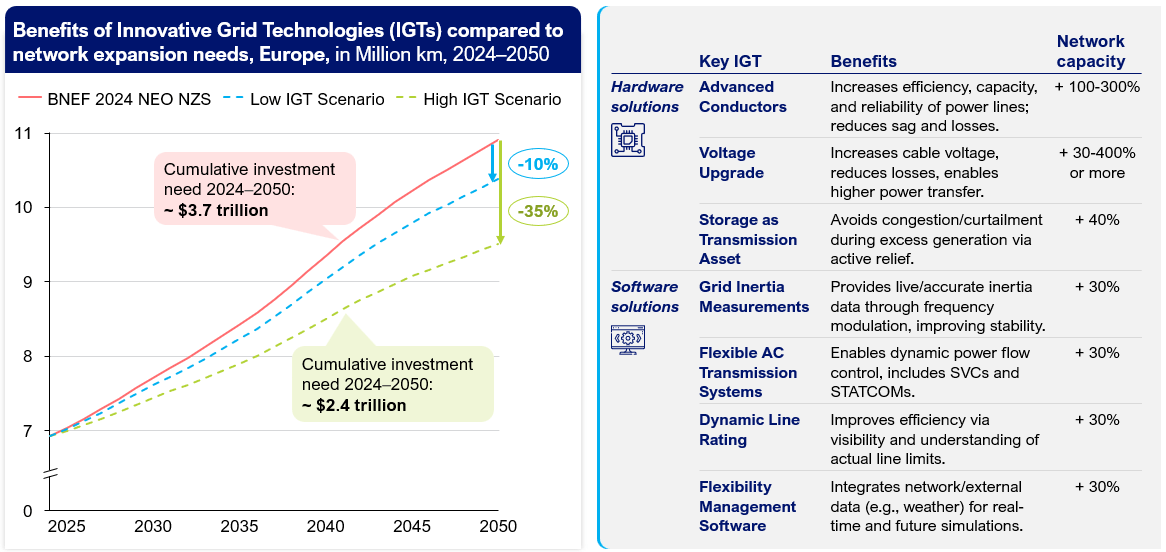This New York Climate Week, the theme “Power On” urges us to sustain the energy in climate action. The clean electricity revolution hinges on innovative electricity grids.
Innovative grid technologies (IGTs) can cut overall power grid investment needs by up to 35 % – or even more in developing regions where more new connections are required. Deployment of IGTs can lower new connection needs, extend grid asset life, and reduce reinforcements requirements. In Europe, this could cumulate a whopping $1.3 trillion in avoided costs between now and 20501, while delivering similar resilience and decarbonisation outcomes.

Buildout of electricity grids is needed because, despite the global turmoil, one trend is not stalling: global electrification. The foundational technologies for electrification, solar PV and batteries, are beyond a positive tipping point and are scaling exponentially. Electrification is widely recognised as a major lever to tackle emissions from buildings, transport and industry (via deployment of commercially available, energy-efficient technologies that substitute fossil fuels with renewable power). This trend is evidenced by EV sales soaring across the world, heat pumps outselling boilers in the US and electric two-/three-wheelers having become cheaper to own than petrol variants in India.
The clean electricity revolution hinges not only on renewable energy generation and storage assets, but also on electricity grids that connect generation to industry, businesses and people. The Energy Transitions Commission (ETC) has launched a report underscoring the urgent need to modernise and expand grids to deliver clean, reliable, and cost-competitive power systems. Today’s grids were built for a fossil-based system with centralised power plants, not for a decentralised, renewable-driven future. Grid capacity constraints are a key barrier towards deeper electrification. In several countries, including the Netherlands and the United States, grid constraints are already a reality: grid congestion blocks new electricity generation capacity from being transmitted, while companies and consumers sometimes wait more than 5 years for a connection. At the same time, existing power grids are heavily underutilised as they are designed for peak demand, which typically only occurs a few hours per year.
Power system transformation requires serious scaling of investments: global investment in grids could grow from around $370 billion in 2024 to a peak of $870 billion per annum in the 2030s and 2040s. About 55% of the total is required in the distribution network and 45% in transmission 1. This is not just about adding more copper wires – it involves replacing aging grid assets, modernising infrastructure, and building capabilities that enable clean power to flow where it is needed most, supporting industrial growth and ensuring reliability in an electrified economy. Given the intense competition for capital and resources in today’s world, we need to be smart about how and where we invest.
IGTs optimise use of existing infrastructure by maximising the network capacity and reducing losses. Commercially ready IGTs include hardware solutions such as advanced conductors, voltage upgrade and ‘storage as transmission asset’, which can achieve network capacity increases of 40 – 400+%. Moreover, software solutions can increase network capacity by ~ 30% through real-time visibility and response, using technologies such as flexible AC transmission systems, dynamic line rating as well as grid inertia and flexibility measurements1. AI is enabling a better offering of these, such as new digital products that can make for higher precision and easier implementation.
Simultaneously, demand-side flexibility solutions can help to reduce peak loads, e.g. through smart charging of electric vehicles, flexible heat pumps, and industrial demand response. Such solutions could time-shift ~ 25 – 40% of global demand by 2050 1, cutting the need for costly overbuild.
Policymakers, grid operators, utilities and technology providers need to step up and take action to scale up IGTs and demand-side flexibility solutions. This requires an integrated strategic vision that aligns renewables, storage, flexibility, and grid investments with system needs, as well as planning. Focus areas should include reforming grid regulations to reward optimisation and unlock investments, closing supply chain and workforce gaps and structuring the electricity market to enable emerging flexibility technologies to compete on equal terms with incumbent assets. Finally, leveraging data and AI modernisation for system optimisation and building consumer trust in demand-side flexibility are no-regret moves.
We are up for a fundamental overhaul of the global energy system. Given the exponential rate of change, our actions must be bold, strategic, and aligned with this accelerated pace. Jointly, decisionmakers can unlock resilient, cost-effective and high-renewable power systems, forming the backbone of a competitive and clean future.

